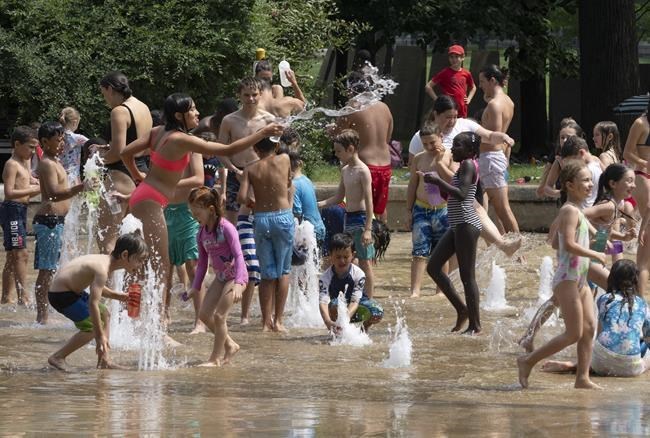TORONTO — William Gaikezheyongai has lived outside long enough to know where to get water in times of extreme heat.
He knows construction workers usually have water bottles in their vans, so he'll ask for one and douse himself with it. On recent hot summer days, he's had to repeat the process every hour or so to stay cool.
"It's hard to find free water and free shelter where someone doesn't say, 'move away,'" says Gaikezheyongai, an Ojibwa man who lives in a teepee near a ravine in Toronto.
"I fainted a couple times and I had seizures."
As several provinces swelter under heat warnings that Environment Canada says could bring temperatures of 30 C or more over the coming days, experts say more needs to be done to support vulnerable groups, including homeless populations, who can be especially affected by extreme heat.
For Gaikezheyongai, the recent weather has meant his teepee gets very hot and his living conditions get extremely uncomfortable.
"It's been really, really difficult," he says.
Blair Feltmate, head of the Intact Centre on Climate Adaptation at the University of Waterloo, says people experiencing homelessness are among the groups most at risk due to extreme heat.
"The same way we accept, as a human right, that people will have warmth and comfort in the winter, we have to start thinking about access to being cool in the summer," says Feltmate.
"It's not just a matter of of being comfortable, it's literally a matter of life and death."
According to an April 2022 report co-authored by Feltmate, extreme heat events create worse conditions in Canada's cities and towns due to the "urban-heat-island effect," in which an urban area is significantly warmer than surrounding areas.
Feltmate says the heat-island effect is caused by sunlight hitting dark or tarred surfaces like factories, shopping malls, apartment buildings and roads, which occupy a large percentage of built up urban areas. When sunlight hits those surfaces, about 80 per cent stays in the area and contributes to warming of about 3 to 5 C, particularly where shade is limited.
"During episodes of extreme heat, everyone is at risk from heat illnesses. But the danger is greatest for those who are already more vulnerable or less able to protect themselves," the report reads.
Diana Chan McNally, a harm reduction case manager at Toronto's All Saints Drop-in, says extreme heat is just as dangerous to those experiencing homelessness as extreme cold weather is in the winter.
"It can be quite deadly to not have low-barrier and accessible cooling centres," she says.
The City of Toronto activates a hot weather response plan from mid-May to the end of September to ensure residents, particularly those vulnerable to the heat, have access to cool spaces.
But that plan does not include specific "cooling centres" this year, with the city saying those locations were found insufficient in the past to minimize health risks.
Instead, the city says it now has a "heat relief network" of 300 locations, including libraries, community centres and pools, as well as shelters and respite centres, where residents can seek a break from the heat.
The city said it also has street teams checking on those living outdoors when heat alerts are in place.
Chan McNally criticized the city for not having dedicated emergency cooling centres as it did in the past.
"This (heat relief network) has things like a swimming pool, which is not accessible for people experiencing homelessness, or a children's splashpad, which is not appropriate to have an adult using," she says.
"What we're asking people who are unhoused to do is essentially fend for themselves and their only real options a lot of the time are to go into privatized spaces, like a Tim Hortons or shopping mall, where a lot of times they are simply not welcome."
According to Feltmate's research, much of Canada is projected to experience extreme temperatures between 2051 and 2080 based on three indicators — maximum daily temperature, number of days where temperatures exceed 30 C and the duration of heat waves.
“The maximum daily temperature is going to go up, the number of days that we experience during the summer, where the temperature exceeds 30 C, are going up, and the length of heat waves will elongate,” Feltmate explains.
In Toronto, Feltmate says the current number of days exceeding 30 C is between 12 to 14 days per summer. By 2050 to 2060, that is expected to rise to 55 days per summer.
Feltmate notes those numbers are fairly consistent with trends in other major cities in Canada.
"That's where we're heading," he says. "As problematic and challenging as we think the extreme heat is that we're experiencing today, it still is relatively mild compared to the extreme heat that's coming."
— With files from Noushin Ziafati.
This report by The Canadian Press was first published July 21, 2022.
Tyler Griffin, The Canadian Press
Note to readers: This is a corrected story. An earlier version included an incorrect name for the research centre at the University of Waterloo.



